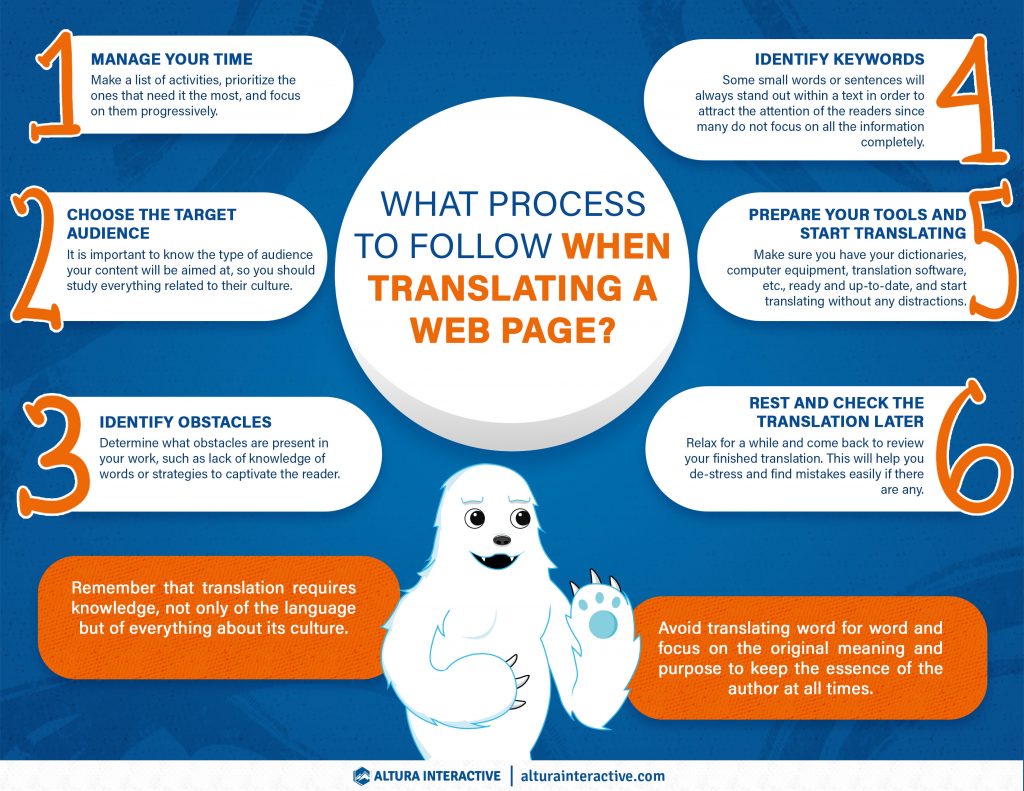If you want to translate a website, you must know the translation processes to make it successfully. This article is a guide to train you on how to transfer to another language information from a web page about any topic without losing its original meaning and without depending on Google’s automatic translator, or some other automated translation program.
First of all, it should be mentioned that these tips are for those who are unfamiliar with translation processes and need help to start translating their website. However, some of these steps may also be helpful to people with some prior experience.
How to translate a web page:
- Manage your time
- Choose the target audience
- Identify obstacles
- Identify keywords and purpose
- Prepare your tools and start translating
- Have some rest and review the translation later
Manage your time
Before translating, the first thing you should do is organize your time to dedicate the necessary to each of the steps to be completed. This is very important because, on many occasions, distractions or other unplanned activities interfere with the rhythm of work flow. Whether you interrupt your activity to prepare a coffee, a snack or even take a break, these small activities can affect the quality of your translation, so it is recommended to do them before starting your tasks.
Translating when following a process allows you to complete your activities in the least number of days possible. Make a list of your priorities and focus on the next steps to carry out your translation.
Choose the target audience
Once you have effectively organized your time, the next thing on the list is to choose the type of audience for which the website will be translated. Take into account not only the language but also the region, as there are regionalisms or words that may have different connotations depending on the geographical area to which you want to focus on.
Examples:
(USA)
(ES)
(MX)
The images above represent the different translations of one of Burger King’s products for the markets of the United States, Spain, and Mexico. This means that it is necessary that you investigate in detail the culture of that region, or the audience you want to reach, which is very valuable because with this process you will be able to gain important information regarding people’s perspectives and their version of reality is like. Remember that each individual thinks differently and by doing a little research on culture or traditions you could express better what you are trying to communicate.
Identify obstacles
Since you have investigated the necessary information to answer your questions and also have selected the language to which you are going to translate, it is time to determine what are the obstacles that are holding you back in your task. It is suggested that you look for examples of translations to guide you on which model to follow for the type of translation.
A common obstacle is running into words you don’t know. A good tip is to look up that word in different texts, as well as different contexts so that you better understand the ways in which you can use that word. Remember, it is not enough just to know the language, since translating not only means transferring words from one language to another, but giving it the same meaning as in the original one, which is essential to maintain the interest of the readers in the content of the website.
Another barrier that you can face is not knowing the correct strategies to get the attention of the users. This has a simple solution and has to do with the intent of the user. Think about what a reader is looking for when they come across your content and make sure you provide something that answers their questions. Therefore, as a translator, you must familiarize yourself with everything that culture encompasses: age, traditions, word variants, etc., and thus ensure that you are communicating the information correctly and that it will be useful to the reader.
Identify keywords
After you have identified the obstacles that interfere with this translation process, it is time to move on and enter a more familiar area. Although it is important to deal with unfamiliar terminology, it is also good to identify those known words that will be key to highlight the content of the site.
When you know the language and have a good control of it, a percentage of words will stand out from the others, which will be of great support to capture the attention of users. Clearly not everyone will have the time or the desire to read the content completely, and precisely with those keywords you will form ideas and will be able to catch people’s attention in just one sentence.
In general, in an Internet search, the most searched words on a specific topic will appear first, though it is not always necessary to use these types of terminology. However, you should focus on finding the correct translation of a word or sentence according to the target culture that also exists in that language.
For example:
(EN)
If you suffered an injury in someone else’s property due to their negligence, you can file a premises liability lawsuit to obtain financial compensation for your damages.
(ES ✘)
Si sufrió una lesión en la propiedad de otra persona debido a su negligencia, puede presentar una demanda por responsabilidad de propiedad para obtener una compensación financiera por sus daños.
(ES ✓)
Si sufrió una lesión en la propiedad de otra persona debido a su negligencia, puede presentar una demanda por responsabilidad civil para obtener una compensación financiera por sus daños.
“Premises liability” is a legal concept for a personal injury occurring on a person’s property, whether due to negligence or carelessness. In the first example, a literal translation of the term can be perceived, but, although it is completely understandable, it is incorrect since in Spanish “responsabilidad civil” is usually used for this type of breach of the law.
Prepare your tools and start translating
Considering that you have followed the previous steps correctly, with the time well organized, your obstacles overcome, and relevant information with you, you are almost ready to translate. However, for this, you will have to prepare all your tools, both physical and digital.
Make sure your computer equipment is in good condition. Your computer or laptop, mouse, keyboard, monitor, etc., should be clean since those are your main tools. Translators are still human, and knowing more than two languages does not mean that they are walking dictionaries, so, in addition to having a good dictionary from one language to another, a smart translator must also have a dictionary of their mother tongue and another one from the target language. Also, it is advisable to have a glossary of terminology on hand to support you.
If you are going to translate your website from English to Spanish, some of the most recommended dictionaries are Real Academia Española or Fundación del Español Urgente. If you need something more specialized you can look for one like Chris Brooker’s Medical Dictionary, Diccionario de la Lengua Publicitaria or Diccionario del Español Jurídico. Depending on the information that you have to translate, it is the type of specialized dictionary that you will use, but these are some of the most used by English – Spanish translators.
It is necessary that you have updated the programs you use for editing files, photos or videos (Photoshop, Adobe Premiere or Abby FineReader) because it is very likely that you will have to change information about advertisements. In the same way, keep up to date the software to change document formats and even those that make your work a little easier, those that work with translation memories, such as SDL Trados, a very popular automated translator. If you acquired one of them through a subscription, do not stop paying for them if they are useful in your daily tasks. Keep in mind that all this entails a great investment that will pay off in the future. In the end, when you already have your computer equipment ready and in optimal conditions, your dictionaries, and your programs working correctly, now you are ready to start.
Have some rest and check the translation later
When you finish your translation, the last thing you have to do is to verify everything is correct. However, since it is very likely you will feel tired, when reviewing the final product your mind will not be in optimal conditions to carry out that task, especially if it was a lot of time invested, that is why it is better to take a good rest and do it later. If you need to, it might also be helpful to read all the information aloud, either to yourself or to someone else. When you read aloud, mistakes in translation are easier to spot, and also if something sounds better in a different way.
One fact that might be of interest to you is that, in the Skopos Theory, created in 1978 by Hans Vermeer, it is emphasized that each translation has a purpose determined by the function of the product, and that function is specified thanks to the recipient. Therefore, the audience is one of the most important factors in determining the purpose of a translation (Du, 2012) and with this, Vermeer also considers the translator as a creator.
With that in mind, a translator also creates, so what is written in your mother tongue will not always sound good when transferred to another language, therefore you must formulate ideas or reform those that are already reflected in the original text. With that being said, carefully analyze which sections of your content need changes or fixes to increase the number of people coming to the web page.
Finally, it is vital to emphasize the fact that translating is not only about translating word by word, but also meaning by meaning. Keeping your activities and working tools in order, researching the necessary information, and having some rest for a good mental performance are the most important factors that will help you accomplish your work, so consider following these steps to translate a website effectively.






